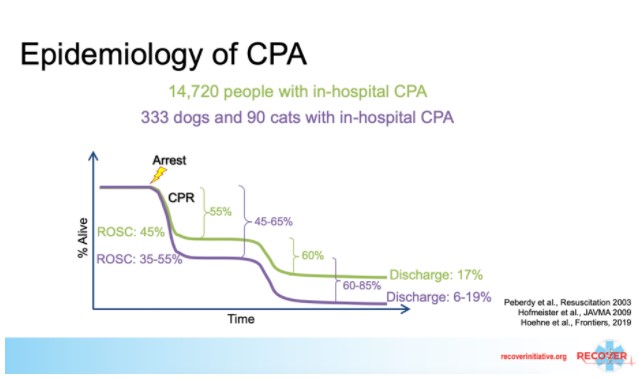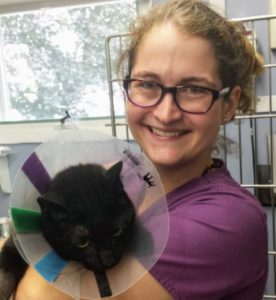
It’s Not Futile – CPR Outcomes in Veterinary Medicine
Some of the questions I get asked when discussing CPR with owners is ‘How well does it work?’ or are they likely to come back?. Dan Fletcher, PhD, DVM, DACVECC is one of the co-chairs of the RECOVER Initiative and in late November he did a live presentation on the RECOVER Initiative Facebook page answering these questions, titled “It’s NOT Futile: What We Know About CPR Outcomes in Dogs and Cats”. Dr. Fletcher started the discussion by comparing human and animal rates of return of spontaneous circulation (ROSC) and subsequent discharge from hospital and then addressing where CPR outcomes started before the implementation of the RECOVER initiative, and where we stand now.
Survival Chance is Different from Patient to Patient
We know that CPR outcomes in people differ from those of animals and we also have a lot more data on humans than animals, making comparing the two a little difficult. Most of the available canine and feline data are from tertiary facilities that are caring for some of the sickest and medically intense cases that often have a poor or grave prognosis. When we compare human outcomes (Peberdy et al., Resuscitation 2003) to canine and feline patients (Hofmeister et al., JAVMA 2009. Hoehne et al., Frontiers, 2019) we see that there is a lower chance of survival to discharge in felines and canines (Figure 1). In humans, 45% of patients achieve ROSC, while in animals it can range from 35-55%. Of these individuals, 17% of humans who arrested were discharged from the hospital, and these numbers may be rising (Dr. Fletcher estimates closer to 20-25% since the publishing of Peberdy et al., Resuscitation 2003). In cats and dogs, we see that survival to discharge is 6-19% post-ROSC. This outlines an important point, that ROSC may be achieved but that does not mean the patient will leave the hospital after an arrest event.

Figure . Comparing percent survival of CPR and discharge of humans and animals arresting in a hospital setting.
In my experience many owners elect not to consent to CPR when they hear a survival to discharge percentage of 6%, but this range of 6-19% doesn’t tell the whole story. When it comes to survival, animals that arrested due to anesthesia-related complications are 14.8 times more likely to be discharged than those that arrest due to other causes (Hoehne et al., Frontiers, 2019). Another study showed that 47% of dogs and 42% of cats that arrested due to an anesthetic event, achieved ROSC and were discharged (Hofmeister et al., JAVMA 2009). Thus, a patient coming in for an anesthetic event that arrests could have an almost 50% chance of being discharged, while a patient who is very critical and battling multiple disease processes may be closer to the 6% chance of surviving ROSC to discharge. Our responsibility as veterinarians and veterinary nurses is to help the owner understand which end of the spectrum their animal is more likely to fall into and advocate for our patients. Being educated in performing effective CPR will also increase our outcome of success in these cases and enable us to help ours make informed decisions.
CPR Knowledge is Improving in the ECC field
So how are we making a difference? How is RECOVER helping? The 6% survival comes from Hofmeister et al., JAVMA 2009 before the RECOVER guidelines were put in place, and the Hoehne et al., Frontiers, 2019 takes place afterward, suggesting that outcomes may be improving. A large part of this is being prepared and having the appropriate training in times of crisis, although most of this data is only generated in a tertiary facility setting.
A study investigating the experience and knowledge base of veterinarians in various practice settings was conducted via the Veterinary Information Network (VIN) in 2010 (Boller et al., JVECC, 2010). A follow-up survey study was done after the publication of the RECOVER guidelines 2019 (Gillespie et. Al., Frontiers Vet Sci, 2019). These studies asked general practitioners in general practice (GPG), general practitioners in an emergency setting (GPE), and board-certified specialists (BCS) to report what chest compression rate they used in feline patients (Figure 2).
| Study | Boller et al., JVECC, 2010 | Gillespie et. Al., Frontiers Vet Sci, 2019 |
| GPG | >30% | >30% |
| GPE | >30% | >40% |
| BCS | <40% | >60% |
Figure 2. Percentage of individuals who correctly guessed 100-120 compressions per minute for a feline in cardiopulmonary arrest.
So, what does this information tell us? Overall, there was an increase in the percentage of correct answers (100-120 compressions per minute) across practitioners exposed to emergency medicine (Figure 2), while the correct response percentage remained the same in general practice. The fact that we are seeing an increase in correct responses from doctors exposed to emergency medicine is wonderful, but now the mission becomes raising that number to 100% across the board.
Employing the Evidence-based Guideline for Better Outcomes
Employing doctors, nurses, and staff that are trained in the best evidence-based practices will lead to better outcomes, and we will continue to increase our survival to discharge percentage. The hope is that one day CPR training becomes as standard in animal hospitals as it is in human hospitals. Until such a time, doing your best as an individual or a practice to gain the knowledge to help you and your patients is paramount. I myself started as the only RECOVER certified rescuer in my emergency and referral hospital and we now have 14 RECOVER rescuers total and even more who have gone through the online RECOVER training and are making a difference for patients every day. Veterinary CPR has come a long way and now we need to work as a community to be trained and ready, learn to lead, and work as a team to help our number of successful outcomes continue to grow.
For the recording of the original RECOVER Short Topic session, go HERE.
Beth Kennett, CVT
RECOVER Certified BLS Instructor
RECOVER Certified ALS Instructor
About Beth Kennet, CVT
 Beth Kennett is a full-time ICU/ER veterinary technician in Burlington, Vermont. She is also a part-time distance learning student in veterinary nursing at Purdue University and has her bachelor’s degree in biology and animal science from the University of Vermont. She has been a part of the RECOVER social media team since January 2020 after becoming a RECOVER Certified Instructor. She shares her home with four black cats (pictured here with her first Gus on his gotcha day) and her hiking buddy Ranger.
Beth Kennett is a full-time ICU/ER veterinary technician in Burlington, Vermont. She is also a part-time distance learning student in veterinary nursing at Purdue University and has her bachelor’s degree in biology and animal science from the University of Vermont. She has been a part of the RECOVER social media team since January 2020 after becoming a RECOVER Certified Instructor. She shares her home with four black cats (pictured here with her first Gus on his gotcha day) and her hiking buddy Ranger.
The opinions expressed in guest blog articles are solely the views of the author. If you are interested in writing a blog article for the RECOVER Initiative, please email media@recoverinitiative.org

